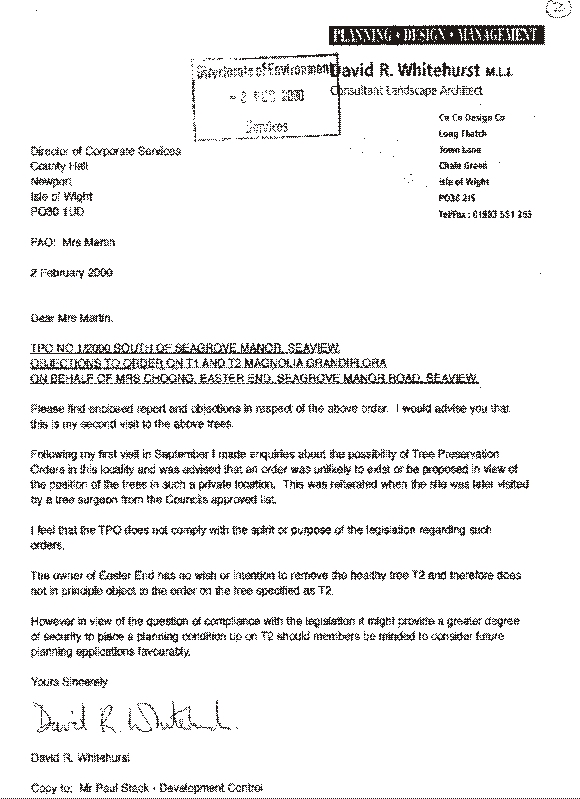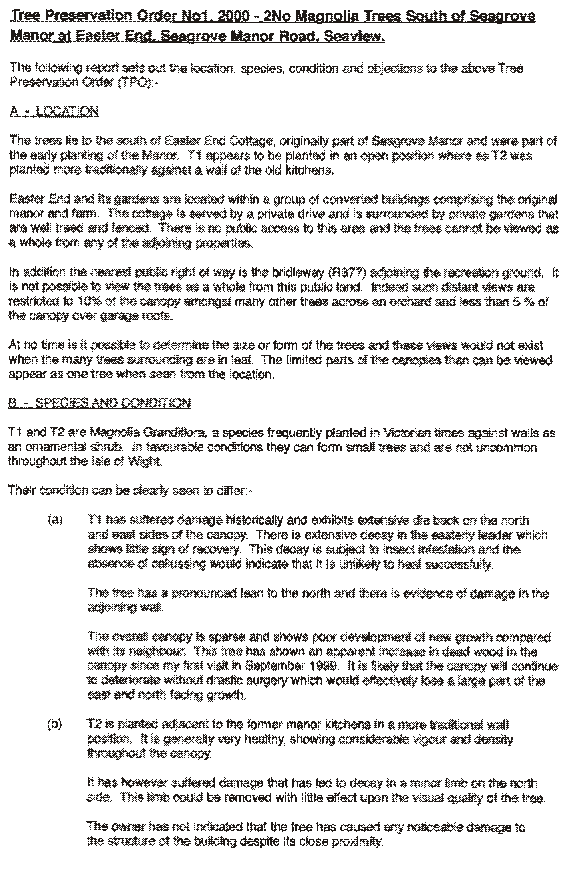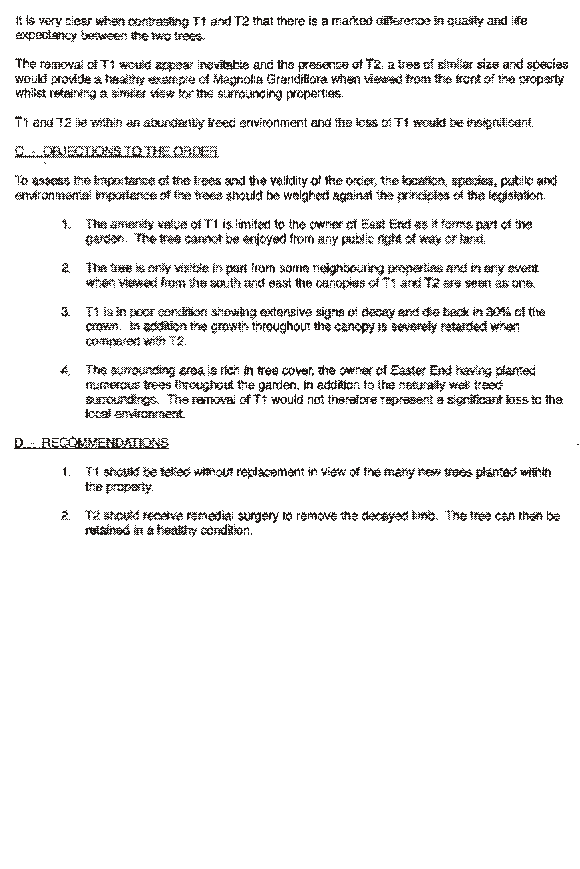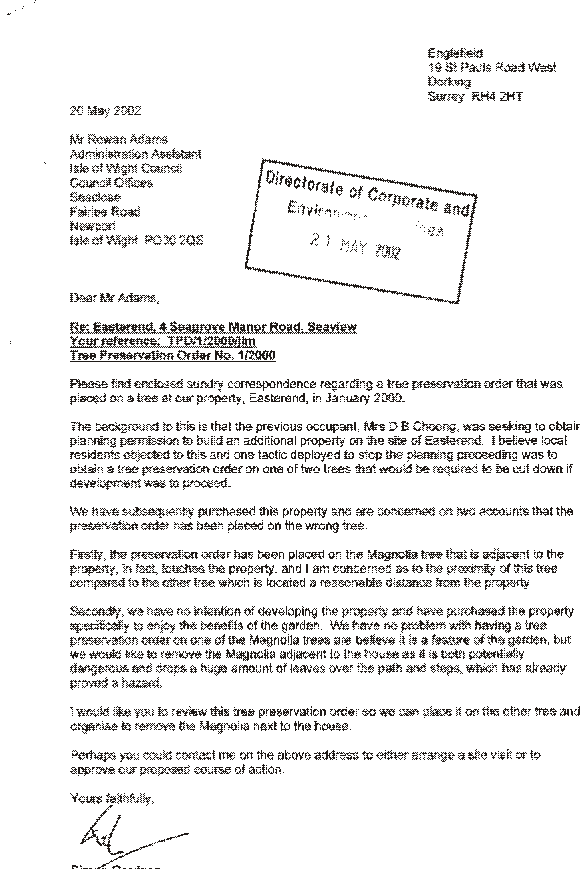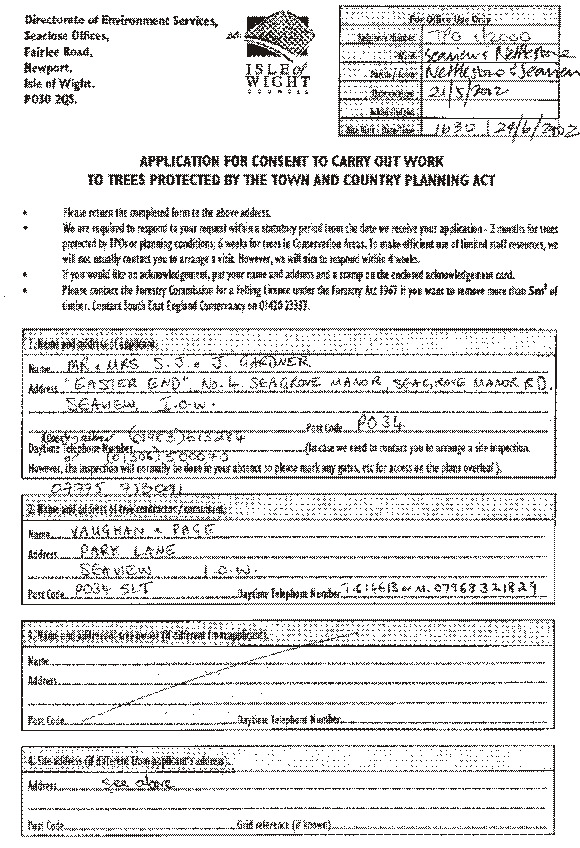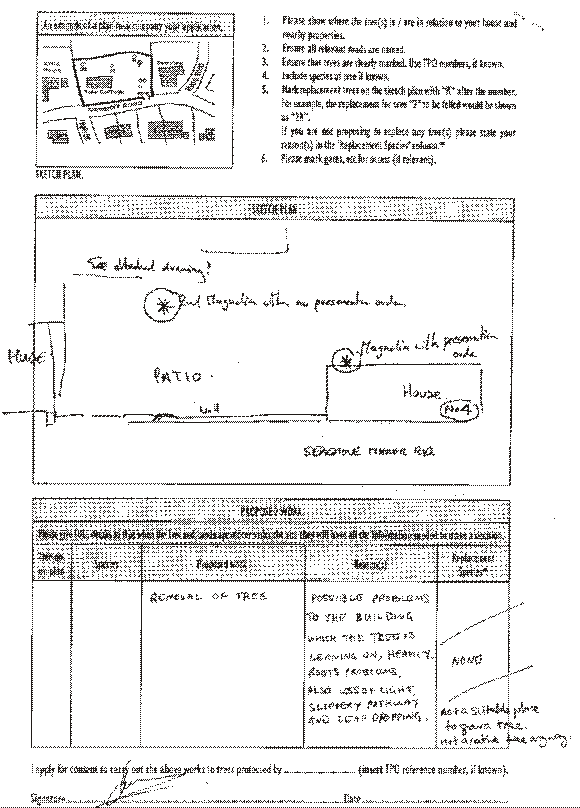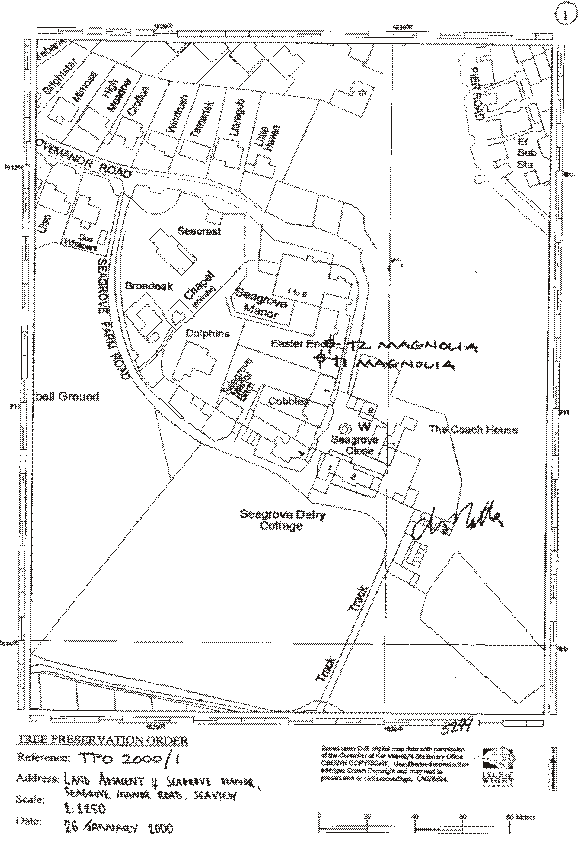
PAPER B2
Purpose: For Decision
Committee: REGULATORY APPEALS COMMITTEE
Date: 25 JULY 2002
Title: TREE PRESERVATION ORDER AT LAND NEXT TO SEAGROVE MANOR, SEAGROVE MANOR ROAD, SEAVIEW - TPO 2000 / 1
REPORT OF THE STRATEGIC DIRECTOR OF CORPORATE AND ENVIRONMENT SERVICES
SUMMARY
Following the submission of a planning application a TPO was placed on two magnolia trees. An objection was received and a decision was made at a meeting of the Regulatory Appeals Committee on 26th June 2000 to confirm the Order, but to exclude T1. The ownership of the property has since changed hands, the proposed development has not been built, and both trees are still there. The new owners wish to remove T2 because of its proximity to the building, but wish to retain the tree which was originally protected as T1.
OPTIONS
1. To grant consent for the removal of T2, without conditions.
2. To grant consent for the removal of T2, on condition that the other magnolia tree originally protected as T1 is retained as a replacement.
3. To grant consent for the removal of T2, on condition that another tree is planted elsewhere in the garden as a replacement.
4. To refuse consent for the removal of T2.
RECOMMENDATION
Members instructions are requested
FINANCIAL IMPLICATIONS
As with any TPO, compensation could be claimed by the applicant if consent to remove the tree or for works to the tree were refused, and the refusal resulted in loss or damage.
ENVIRONMENTAL IMPLICATIONS
Removal of the tree would be not be a loss for the local landscape, as the tree is not significantly visible from any public land.
LEGAL IMPLICATIONS
T2 could at some future date cause damage to the building. If consent is refused, the applicant might be able to claim successfully against the Council for any future damage caused by the tree. There is no damage at present, nor current evidence of imminent risk of damage. However it is foreseeable that the tree might cause actual damage to the building, most probably the roof, in the future.
If consent is refused to remove the tree, there is a likelihood that any appeal against this decision would succeed regardless of any other circumstances because the Order does not appear to have been made in accordance with the current DETR guidelines, although it is legally valid.
BACKGROUND
Planning History
Planning application TCP 23254, for development at Easter End, Seagrove Manor Road, Seaview, was considered at a meeting of the Planning & Countryside Committee on 25th January 2000. There are two magnolia trees on site but these are not visible from any public land so in line with normal practice the Planning Officer had not requested a professional opinion from the Tree & Landscape Officer.
Before the meeting and at the request of the local Member the Tree & Landscape Officer visited the site on 25th January. A verbal report based on her notes was given to the meeting. The Tree & Landscape Officer’s notes included the following statements:
‘There appear to be two trees at the eastern end of the site, visible from Seagrove Close. The trees appear to be bull bay, Magnolia grandiflora. The southern tree ... [T1] appears healthy viewed from outside the site. The northern tree [T2] is also large but does appear rather yellow suggesting that it is not so healthy.
The southern tree [T1] at least has “significant amenity value” and if it were visible from public land I would certainly wish to place a TPO on it if I believed it were under threat.
Unfortunately ... neither of these trees is visible from a public place. Seagrove Close is a private road. There is a gate at its southern end with a sign reading “Seagrove Close/Private”. There is a notice on the eastern wall at the southern entrance reading “Seagrove Close/Private/No right of way”. There is also a sign at the northern side of the northern entrance, to the east of “Little Haven”, Seagrove Manor Road, which reads “No right of way/Private Road/Access to/Seagrove Manor/& Close only/Dead Slow”.
There is therefore clearly not even any permissive public access. The trees are not visible from either of the two nearest public rights of way, the adopted part of Seagrove Manor Road or public bridleway R67. There are therefore unfortunately no grounds for making a TPO.’
Making and confirming of the Tree Preservation Order
The Committee resolved to make a Tree Preservation Order to cover the trees. The Order was made on 27th January.
An objection was received on 3rd February from an agent acting on behalf of the owner of Easter End.
The Regulatory Appeals Committee met on 26th June 2000. They were told that:
“The decision to make the TPO might be justified on the basis of the Government Circular Number 36/78 “Trees and Forestry”, paragraph 40, quoted in the DoE’s documents “Tree Preservation Orders: A Guide to the Law and Good Practice” (October 1994) which has since been updated by the DETR in March 2000. This reads:
“The trees, or at least part of them, should therefore normally be visible from a public place, such as a road or footpath, although, exceptionally, the inclusion of other trees may be justified.”
However, to pass this test, the trees or the circumstances must obviously be ‘exceptional’. In this instance neither is the case. Bull bays, Magnolia grandiflora, are not particularly common, but neither are they particularly rare - at least one example could be found in most towns in southern England. Furthermore there are no exceptional circumstances - for example, no unusual ecological or historic value which might justify the inclusion of these trees such an Order.
In the objection (Appendix A) the landowner has clearly taken professional advice on the health of the trees, and has discovered that one of them (T1) is diseased and possibly dying. Having done so, and informed the Council, there is no reason in law why the landowner should do works to that tree or possibly even fell the tree, as the Council has no power to prevent works to dead, dying or dangerous trees, even if the TPO is valid and confirmed. This will remain the case regardless of any decision by the Council.
For these reasons the recommended option is not to confirm the Order on the grounds that the Council cannot show for either tree that a reasonable degree of public benefit would accrue before the Order is confirmed.
However, if the Committee are still minded to confirm the Order it is recommended that the Order be modified to exclude the diseased tree, T1. It is unlikely that the Order will protect this tree in any case, and the landowner has expressed no objection to the retention of T2.”
The Regulatory Appeals Committee resolved to confirm the Order, but to exclude T1.
Application for works
An application for consent to remove T2 was received on 21st May 2002. The reasons stated were “possible problems to the building which the tree is leaning on, heavily; roots problems, also loss of light, slippery pathway and leaf dropping”. The accompanying letter says that the new owners believe the Tree Preservation Order was placed on the wrong tree on two grounds:
“Firstly, the preservation order has been placed on the Magnolia tree that is adjacent to the property, in fact, touches the property, and I am concerned as to the proximity of this tree compared to the other tree which is located a reasonable distance from the property.
“Secondly, we have no intention of developing the property and have purchased the property specifically to enjoy the benefits of the garden. We have no problem with having a tree preservation order on one of the Magnolia trees we believe it is a feature of the garden, but we would like to remove the Magnolia tree adjacent to the house as it is both potentially dangerous and drops a huge amount of leaves and paths over the steps, which has already proved a hazard.”
The Tree & Landscape Officer visited the site on 25th June 2002, and later discussed the application with the applicant.
T2 is indeed so close to Easter End that it touches the building. The base of the trunk is already touching the base of the wall; the trunk is so close to the roof that a gutter has not been fixed to the part of the eaves nearest the tree, because the trunk is touching the tiles, leaving no space for a gutter; and the tree’s canopy overhangs the roof. British Standard BS 5837 : 1991 “Guide for Trees in relation to Construction” Table 2 gives guidance on minimum distances between structures and young trees or new planting. The relevant minimum distances recommended are:
Minimum distances in metres between structures and young trees or new planting |
||
|
mature height of tree |
|
type of structure |
up to 8 m |
8 - 15 m |
building |
- |
0.5 |
underground services less than 1 m deep |
0.5 |
1.5 |
flexible paving such as paving slabs |
0.7 |
1.5 |
T2 is currently less than 8 m in height, estimated at 5-6 m. It still has a relatively dense crown as noted by the previous owner’s agent, but it is not particularly healthy, having yellowish leaves still two years after this was first noted by the Tree & Landscape Officer. It is possible therefore that it will never reach more than 8 m in height, although there are Magnolia grandiflora trees elsewhere on the Island which are about 8 m or more in height. The guidance would suggest that its distance of less than 0.5 m from the building is therefore acceptable. However the trunk is already touching the building and as it expands in future years it will therefore be exerting pressure on the wall. BS 5837 paragraph 10.2.2 states that buildings may be strong enough to withstand these forces without damage, and indeed the Tree & Landscape Officer noticed no damage on 25th June, nor has the applicant claimed that any such damage has occurred as yet, and neither did the previous owner. However BS 5837 also points out in paragraph 10.2.1 that trees may cause direct damage to underground services, and there is an electricity cable less than 0.5 m from the tree, closer than the recommended minimum distance.
In addition, and perhaps most significantly, the tree is overhanging the roof, as the building at this point is single storey. There is also therefore a relatively high risk that if the tree drops even small branches that these might damage the roof.
Removal of T2 would therefore reduce the risk of damage to the building.
The tree originally protected as T1 is still present. As noted by the previous owner’s agent, it has a thin canopy and there is decay still in one branch which has not been removed. However the leaves, although more yellowish than would be expected in a healthy Magnolia grandiflora, are still greener and appear healthier than those of T2.
If consent were granted for the removal of T2 on safety grounds, it would be unreasonable to make this conditional on the planting of another tree. A new tree should not be planted this close to a building because of the risk of damage; and there is not enough room near to T2 but far enough from the building to plant a new tree, since the tree originally protected as T1 already occupies the obvious position for such a replacement.
If T2 were removed and the tree originally protected as T1 were retained there would be little loss of private amenity within the grounds of Easter End. There would be no loss of public amenity as neither tree is significantly visible from any public land.
BACKGROUND PAPERS
1. Plan from original TPO / 2000 / 1 showing both T2 (confirmed) and T1 (excluded from confirmed Order).
2. Letter objecting to the Order dated 2nd February 2000 from agent acting on behalf of previous owner of Easter End.
3. Minutes of Regulatory Appeals Committee meeting 26th June 2000.
4. Application for consent to remove T2, and accompanying letter, dated 20th May 2002 received 21st May 2002.
5. “Tree Preservation Orders: A Guide to the Law and Good Practice” DETR March 2000.
6. British Standard BS 5837 : 1991 “Guide for Trees in relation to Construction”
M J A FISHER
Strategic Director Corporate and Environment Services

